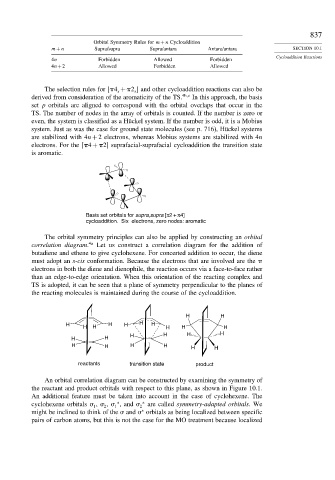Page 853 - Advanced Organic Chemistry Part A - Structure and Mechanisms, 5th ed (2007) - Carey _ Sundberg
P. 853
837
Orbital Symmetry Rules for m+n Cycloaddition
m+n Supra/supra Supra/antara Antara/antara SECTION 10.1
Cycloaddition Reactions
4n Forbidden Allowed Forbidden
4n+2 Allowed Forbidden Allowed
The selection rules for [ 4 + 2 ] and other cycloaddition reactions can also be
s
s
derived from consideration of the aromaticity of the TS. 4b c In this approach, the basis
set p orbitals are aligned to correspond with the orbital overlaps that occur in the
TS. The number of nodes in the array of orbitals is counted. If the number is zero or
even, the system is classified as a Hückel system. If the number is odd, it is a Mobius
system. Just as was the case for ground state molecules (see p. 716), Hückel systems
are stabilized with 4n + 2 electrons, whereas Mobius systems are stabilized with 4n
electrons. For the [ 4 + 2] suprafacial-suprafacial cycloaddition the transition state
is aromatic.
Basis set orbitals for supra,supra [π2 + π4]
cycloaddition. Six electrons, zero nodes: aromatic
The orbital symmetry principles can also be applied by constructing an orbital
correlation diagram. 4a Let us construct a correlation diagram for the addition of
butadiene and ethene to give cyclohexene. For concerted addition to occur, the diene
must adopt an s-cis conformation. Because the electrons that are involved are the
electrons in both the diene and dienophile, the reaction occurs via a face-to-face rather
than an edge-to-edge orientation. When this orientation of the reacting complex and
TS is adopted, it can be seen that a plane of symmetry perpendicular to the planes of
the reacting molecules is maintained during the course of the cycloaddition.
H H
H H H H H
H H H H H
H H H H
H H
H H H H H H
reactants transition state product
An orbital correlation diagram can be constructed by examining the symmetry of
the reactant and product orbitals with respect to this plane, as shown in Figure 10.1.
An additional feature must be taken into account in the case of cyclohexene. The
cyclohexene orbitals , , , and ∗ are called symmetry-adapted orbitals.We
∗
1 2 1 2
might be inclined to think of the and orbitals as being localized between specific
∗
pairs of carbon atoms, but this is not the case for the MO treatment because localized

